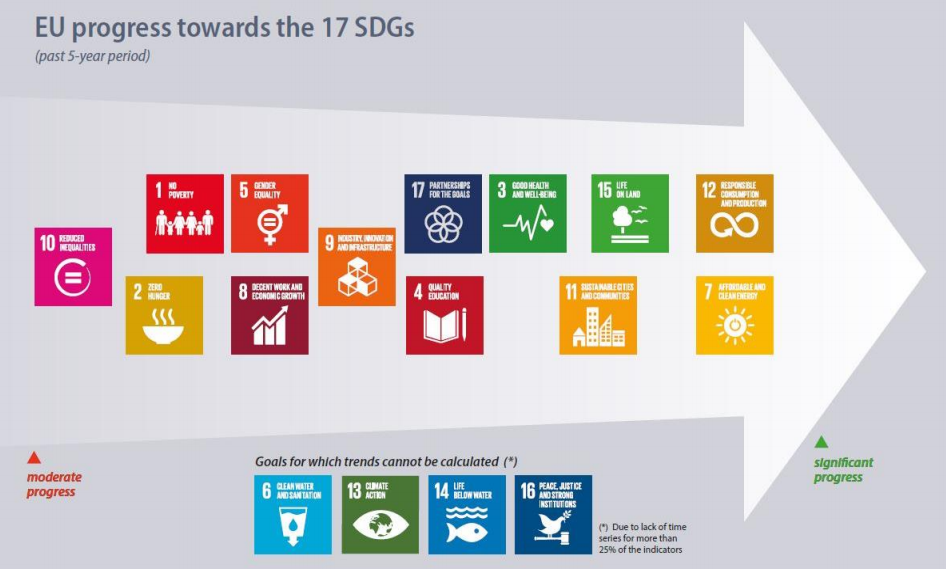Eurostat, the statistical office of the European Union, issues today the publication ‘Sustainable development in the European Union – 2017 monitoring report of the progress towards the SDGs in an EU context’. It provides a first statistical overview of trends relating to the SDGs in the EU. This publication is accompanied by a short brochure, also released today, providing a visual summary of the main findings of the full report.
Introduction
Sustainable development aims to achieve a continuous improvement in citizens’ quality of life and well-being. This involves the pursuit of economic progress, while safeguarding the natural environment and promoting social justice. For these reasons, sustainable development is a fundamental and overarching objective of the European Union.
The 2030 Agenda for Sustainable Development and its 17 Sustainable Development Goals (SDGs), adopted by the United Nations in September 2015, have given a new impetus to global efforts for achieving sustainable development. The EU is committed to playing an active role to maximise progress towards the SDGs, as outlined in its Communication ‘Next steps for a sustainable European future’.
Monitoring progress
As of today, Eurostat’s website hosts a renewed dedicated section on measuring sustainable development in the EU and presents the results of the monitoring report in a series of Statistics Explained articles. The monitoring report describes progress made using a set of 100 indicators that are structured along the 17 SDGs. Two periods are considered: the short term, accounting for progress over the past five years, and the long term (when allowed by data availability), looking at the trends over the last 15 years. To provide a snapshot of overall development for each SDG, a synopsis presents a summary at goal level, while thematic chapters, one for each of the 17 SDGs, provide a detailed assessment of each related indicator.
Results
Overall the EU made progress towards the 17 SDGs over the past five years. Progress for some goals has been faster than for others. In addition, within goals, movement away from the sustainable development objectives also happened in specific areas.
These trends are described in the thematic chapters on the individual SDGs.
Significant progress towards the objectives for five SDGs over the past 5-year period…
The EU made significant progress over the last 5 years towards the overall achievement of SDG 7 ‘Affordable and clean energy’, SDG 12 ‘Responsible consumption and production’, SDG 15 ‘Life on land’, SDG 11 ‘Sustainable cities and communities’ and SDG 3 ‘Good health and well-being’. … and moderate progress for eight others
For eight SDGs, the EU made overall moderate progress over the past five years. Such moderate trends are visible for SDG 4 ‘Quality education’, SDG 17 ‘Partnership for the goals’, SDG 9 ‘Industry, innovation and infrastructure’, SDG 5 ‘Gender equality’, SDG 8 ‘Decent work and economic growth’, SDG 1 ‘No poverty’, SDG 2 ‘Zero hunger’ and SDG 10 ‘Reduced inequalities’.
In the case of four goals – SDG 6 ‘Clean water and sanitation’, SDG 13 ‘Climate action’, SDG 14 ‘Life below water’ and SDG 16 ‘Peace, justice and strong institutions’ – trends cannot be calculated due to insufficient data over the past five years.
Progress towards a given goal does not necessarily mean that the status of that goal is satisfactory for the EU. For example, in the case of SDG 15, which focuses on terrestrial ecosystems, most indicators show good progress, but this does not allow to conclude that ecosystems or biodiversity in the EU are in good health.
Geographical information
The European Union (EU) includes Belgium, Bulgaria, the Czech Republic, Denmark, Germany, Estonia, Ireland, Greece,
Spain, France, Croatia, Italy, Cyprus, Latvia, Lithuania, Luxembourg, Hungary, Malta, the Netherlands, Austria, Poland,
Portugal, Romania, Slovenia, Slovakia, Finland, Sweden and the United Kingdom.



